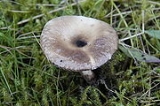
Arrhenia
Encyclopedia
Arrhenia is a genus
of about 25 species in the Tricholomataceae
family. Arrhenia also includes species formerly placed in the genera Leptoglossum and Phaeotellus and the lectotype
species itself has an unusual growth form (discussed below) that would not normally be called agaric
oid. All of the species grow in association with photosynthetic cryptogams such as moss
es, including peat moss, and alga scums on decaying wood, and soil crusts consisting of mixes of such organisms. Typically the fruitbodies
of Arrhenia species are grey to black or blackish brown, being pigmented by incrusting melanized
pigment
s on the hypha
e.
Genus
In biology, a genus is a low-level taxonomic rank used in the biological classification of living and fossil organisms, which is an example of definition by genus and differentia...
of about 25 species in the Tricholomataceae
Tricholomataceae
The Tricholomataceae are a large family of mushrooms within the Agaricales. A classic "wastebasket taxon", the Tricholomataceae is inclusive of any white-, yellow-, or pink-spored genera in the Agaricales not already classified as belonging to the Amanitaceae, Lepiotaceae, Hygrophoraceae,...
family. Arrhenia also includes species formerly placed in the genera Leptoglossum and Phaeotellus and the lectotype
Lectotype
In botanical nomenclature and zoological nomenclature, a lectotype is a kind of name-bearing type. When a species was originally described on the basis of a name-bearing type consisting of multiple specimens, one of those may be designated as the lectotype...
species itself has an unusual growth form (discussed below) that would not normally be called agaric
Agaric
An agaric is a type of fungal fruiting body characterized by the presence of a pileus that is clearly differentiated from the stipe , with lamellae on the underside of the pileus. "Agaric" can also refer to a basidiomycete species characterized by an agaric-type fruiting body...
oid. All of the species grow in association with photosynthetic cryptogams such as moss
Moss
Mosses are small, soft plants that are typically 1–10 cm tall, though some species are much larger. They commonly grow close together in clumps or mats in damp or shady locations. They do not have flowers or seeds, and their simple leaves cover the thin wiry stems...
es, including peat moss, and alga scums on decaying wood, and soil crusts consisting of mixes of such organisms. Typically the fruitbodies
Basidiocarp
In fungi, a basidiocarp, basidiome or basidioma , is the sporocarp of a basidiomycete, the multicellular structure on which the spore-producing hymenium is borne. Basidiocarps are characteristic of the hymenomycetes; rusts and smuts do not produce such structures...
of Arrhenia species are grey to black or blackish brown, being pigmented by incrusting melanized
Melanin
Melanin is a pigment that is ubiquitous in nature, being found in most organisms . In animals melanin pigments are derivatives of the amino acid tyrosine. The most common form of biological melanin is eumelanin, a brown-black polymer of dihydroxyindole carboxylic acids, and their reduced forms...
pigment
Pigment
A pigment is a material that changes the color of reflected or transmitted light as the result of wavelength-selective absorption. This physical process differs from fluorescence, phosphorescence, and other forms of luminescence, in which a material emits light.Many materials selectively absorb...
s on the hypha
Hypha
A hypha is a long, branching filamentous structure of a fungus, and also of unrelated Actinobacteria. In most fungi, hyphae are the main mode of vegetative growth, and are collectively called a mycelium; yeasts are unicellular fungi that do not grow as hyphae.-Structure:A hypha consists of one or...
e.
Species
- A. acerosa
- A. alnetorum
- A. andina
- A. antarctica
- A. auriscalpium
- A. australis
- A. baeospora
- A. chilensis
- A. chlorocyanea
- A. epichysium
- A. elegans
- A. fissa
- A. griseopallida
- A. hohensis
- A. lobata
- A. lundellii
- A. obatra
- A. obscurata
- A. omnivora
- A. onisca
- A. parvivelutina
- A. pauxilla
- A. peltigerina
- A. philonotis
- A. pubescentipes
- A. rainierensis
- A. retiruga
- A. rickenii
- A. rigidipes
- A. rustica
- A. salina
- A. sphaerospora
- A. sphagnicola
- A. spathulata
- A. stercoraria
- A. subglobispora
- A. subobscura
- A. subumbratilis
- A. trigonospora
- A. umbratillis
- A. velutipes
- A. viridimammata
- A. volkertii

